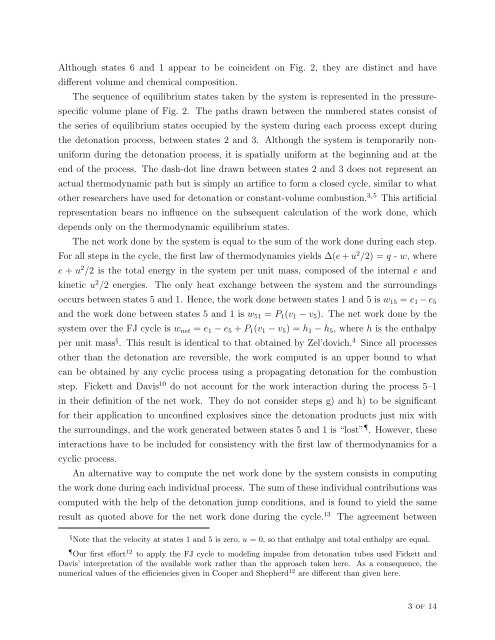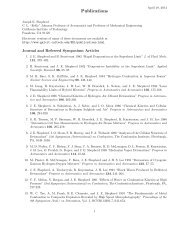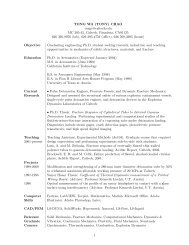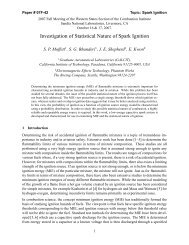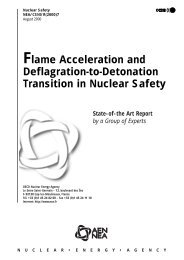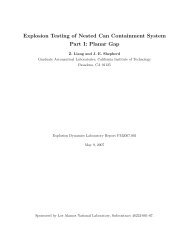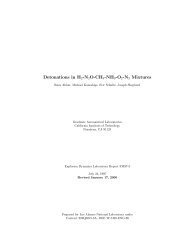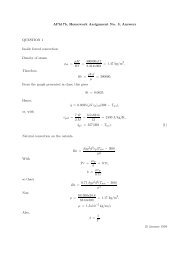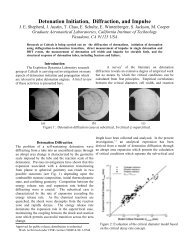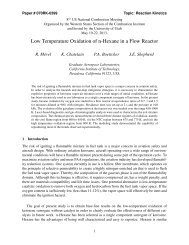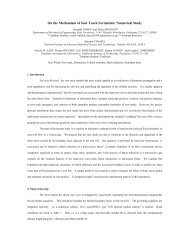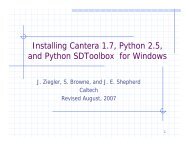Thermodynamic Cycle Analysis for Propagating Detonations
Thermodynamic Cycle Analysis for Propagating Detonations
Thermodynamic Cycle Analysis for Propagating Detonations
You also want an ePaper? Increase the reach of your titles
YUMPU automatically turns print PDFs into web optimized ePapers that Google loves.
Although states 6 and 1 appear to be coincident on Fig. 2, they are distinct and havedifferent volume and chemical composition.The sequence of equilibrium states taken by the system is represented in the pressurespecificvolume plane of Fig. 2. The paths drawn between the numbered states consist ofthe series of equilibrium states occupied by the system during each process except duringthe detonation process, between states 2 and 3. Although the system is temporarily nonuni<strong>for</strong>mduring the detonation process, it is spatially uni<strong>for</strong>m at the beginning and at theend of the process. The dash-dot line drawn between states 2 and 3 does not represent anactual thermodynamic path but is simply an artifice to <strong>for</strong>m a closed cycle, similar to whatother researchers have used <strong>for</strong> detonation or constant-volume combustion. 3, 5 This artificialrepresentation bears no influence on the subsequent calculation of the work done, whichdepends only on the thermodynamic equilibrium states.The net work done by the system is equal to the sum of the work done during each step.For all steps in the cycle, the first law of thermodynamics yields ∆(e + u 2 /2) = q - w, wheree + u 2 /2 is the total energy in the system per unit mass, composed of the internal e andkinetic u 2 /2 energies. The only heat exchange between the system and the surroundingsoccurs between states 5 and 1. Hence, the work done between states 1 and 5 is w 15 = e 1 − e 5and the work done between states 5 and 1 is w 51 = P 1 (v 1 − v 5 ). The net work done by thesystem over the FJ cycle is w net = e 1 − e 5 + P 1 (v 1 − v 5 ) = h 1 − h 5 , where h is the enthalpyper unit mass § . This result is identical to that obtained by Zel’dovich. 4Since all processesother than the detonation are reversible, the work computed is an upper bound to whatcan be obtained by any cyclic process using a propagating detonation <strong>for</strong> the combustionstep. Fickett and Davis 10 do not account <strong>for</strong> the work interaction during the process 5–1in their definition of the net work. They do not consider steps g) and h) to be significant<strong>for</strong> their application to unconfined explosives since the detonation products just mix withthe surroundings, and the work generated between states 5 and 1 is “lost” . However, theseinteractions have to be included <strong>for</strong> consistency with the first law of thermodynamics <strong>for</strong> acyclic process.An alternative way to compute the net work done by the system consists in computingthe work done during each individual process. The sum of these individual contributions wascomputed with the help of the detonation jump conditions, and is found to yield the sameresult as quoted above <strong>for</strong> the net work done during the cycle. 13The agreement between§ Note that the velocity at states 1 and 5 is zero, u = 0, so that enthalpy and total enthalpy are equal. Our first ef<strong>for</strong>t 12 to apply the FJ cycle to modeling impulse from detonation tubes used Fickett andDavis’ interpretation of the available work rather than the approach taken here. As a consequence, thenumerical values of the efficiencies given in Cooper and Shepherd 12 are different than given here.3 of 14


